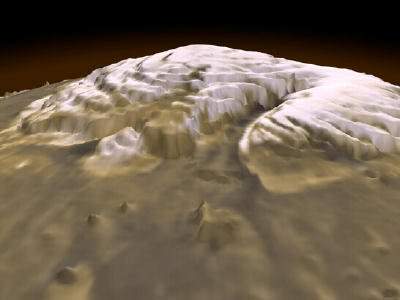[/caption] Planum Boreum, Mar's north polar cap contains water ice "of a very high degree of purity," according to an international study. Using radar data from the SHARAD (SHAllow RADar) instrument on board the Mars Reconnaissance Orbiter (MRO), French researchers say the data point to 95 percent purity in the polar ice cap. The north polar cap is a dome of layered, icy materials, similar to the large ice caps in Greenland and Antarctica, consisting of layered deposits, with mostly ice and a small amount of dust. Combined, the north and south polar ice caps are believed to hold the equivalent of two to three million cubic kilometers (0.47-0.72 million cu. miles) of ice, making it roughly 100 times more than the total volume of North America's Great Lakes, which is 22,684 cu. kms (5,439 miles).
The study was done by researchers at France's National Institute of Sciences of the Universe (Insu), using the Italian built SHARAD radar sounder on the US built MRO. SHARAD looks for liquid or frozen water in the first few hundreds of feet (up to 1 kilometer) of Mars' crust by using subsurface sounding. It can detect liquid water and profile ice.
Mars southern polar cap was once thought to be carbon dioxide ice, but ESA's Mars Express confirmed that it is composed of a mixture of water and carbon dioxide.
The study on Mars north polar cap appears in the journal Geophysical Research Letters, published by the American Geophysical Union.
Source:
PhysOrg
 Universe Today
Universe Today
